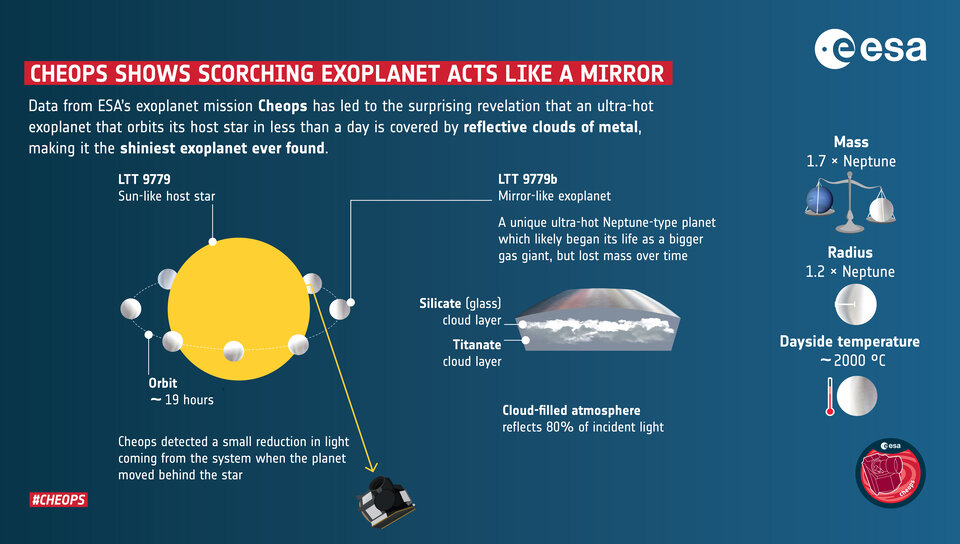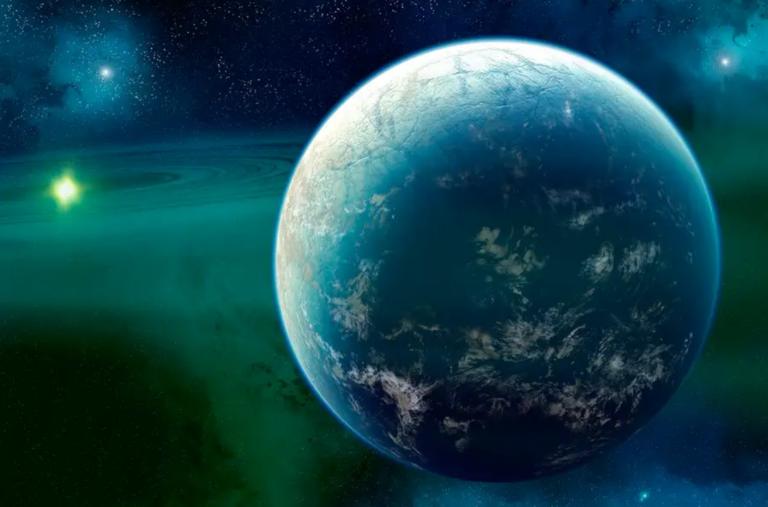Dazzling exoplanet reflects 80% of the light from its star
Other than the moon, Venus is the brightest object routinely visible during night, its thick clouds are known to reflect a little over seventy five percent of sunlight. In contrast, Earth as a planet reflects about 30% of the solar radiation that comes to its surface.
For the first time, astronomers have discovered an exoplanet that is as bright as Venus: planet LTT9779 b. New accurate measurements carried out by ESA’s Cheops reveal that this planet in the habitable zone of its star scatters back roughly 80% of the starlight.
Cheops observations were carefully planned as a follow-up for the initial detection and characterization of the planet in 2020 by the space probe TESS of NASA, as well as other facilities of the ESO HARPS located in Chile.
The exoplanet is approximately Neptune size; thus, GJ 1214b is the largest ‘mirror’ in the universe that humans have discovered to date. This is because its surface is covered with metallic clouds, which are the reasons for high reflectivity. These are mainly composed of silicate, which is similar to sand and glass, containing alongside metals like titanium.
“Picture a blazing sphere as close to its star as Mercury with thick fogs of metals soaring above the landscape, which rains one small particulate of titanium,” declares Dr James Jenkins, astronomer, Universidad Diego Portales and CATA, Santiago, Chile. There to James’ amazement was a scholarly paper which he co-authored, detailing the new discovery, was published in the journal Astronomy & Astrophysics today.

A sky full of metallic clouds
The ‘albedo’ of an item is the ratio of the amount of light reflected from an object to the total amount of light shed on it. Micro-meteorology commonly shows low albedo values for most planets, which can be explained either by the presence of an absorbing atmosphere or because the surface of the planet is either dark or irregular. Exemptions are the extrasolar ice cold ice giants and planets with the reflectingcloudy atmosphere like Venus.
The fact that the albedo is high was quite unexpected taking into account that one side of the planet LTT9779 is facing the star and the temperatures should be roughly 2000 °C. Any temperature more than 100 °C is not suitable for Clouds of water but the temperature on this planet’s atmosphere should not be favorable for Clouds of metal or glass.
Finally, Vivien Parmentier of the Observatory of Côte d’Azur in France and co-author of the work also commented the above-mentioned idea: “It was really a puzzle, until we realised we should think about this cloud formation in the same way as condensation forming in a bathroom after a hot shower. ”Vivien explains: “To steam up a bathroom, one can choose to cool the air until the water vapour turns to water droplets, or on the other hand, one can choose to keep running the hot water until there are cloud formations because the amount of vapour in the air cannot be contained any further. Similarly, the temperature of LTT9779 b may reach very high level if to take into account that this environment can cause formation of metallic clouds due to oversaturation with silicate and metal vapours.
The planet that should not exist
The discovery that LTT9779 b is shiny is not the only shock. Its size and temperature categorize it as an ‘ultra-hot Neptune’; however, no other similar sized or massive planets have been found to orbit this close to their host star. This implies that it resides in the ‘hot Neptune desert’.
LTT9779 b has a radius of 4. 7 times that of the earth and it takes only 19 hours for a year on the planet. All previously discovered planets that orbit their star in less than a day are ‘hot Jupiters’ which are gaseous planets with radius larger than ten Earths or ‘compact’ planets with radii less than two times Earth.
According to Vivien, “It’s a planet that shouldn’t exist. ”“Scientists believe that planets like this should have their atmosphere stripped by their star, and be left as rocks. ”
The first author of the paper, Sergio Hoyer from the Marseille Astrophysics Laboratory, elaborated, “We think these metal clouds allow the planet to exist in the hot Neptune desert The clouds also reflect light which does not make the planet too hot and evaporate In the meantime, the extreme metallic nature of the planet as well as its atmosphere makes it more massive and harder to eject. ”
Observing an exoplanet when it is concealed
An example of this is where we can use several equipment in order to get the total picture of the exoplanet. “We see that LTT9779 b is a prime target for a follow-up with the help of the capabilities of both the Hubble and the James Webb Space Telescope,” adds Emily Rickman, the ESA scientific operations scientist. “They will help us study this exoplanet using a wider band of light and colors, such as infrared and ultraviolet that will help in determining what is within this planet’s atmosphere. ”
Future of the research of exoplanets looks promising since Cheops is the first of three dedicated exoplanet missions. This will happen in 2026, and Plato is going to target Earth-like planets that orbit at distances which could make them viable habitats for life. Ariel will come online in 2029 and will focus on characterizing the atmospheric compositions of the discovered planets.
S. Hoyer et al. (2023) presented an article on the unusually high albedo of LTT 9779 b discovered by Cheops. doi: https://www.aanda.org/10.1051/0004-6361/202346117.
Do not forget to share your opinion with us to provide you with the best posts !




0 Comments